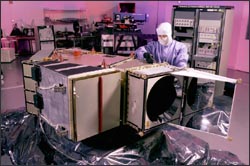Menu

Technical descriptions of the Landsat satellites can be found by following the links at the bottom of this page.
For regularly updated information on the Landsats 5, 7, and 8 missions visit the USGS Landsat website.
For detailed information on Landsat 7 data use, visit the Landsat 7 Science Data Users Handbook.
Visual comparison of Landsat spectral bands

Full spectral response data is located here: TM/ETM+, OLI, TIRS
To compare the exact band designations in tabular form, please visit the USGS page “What are the band designations for the Landsat satellites?” For detailed information on Landsat 8 (formerly the Landsat Data Continuity Mission, LDCM), visit the Landsat 8 section of this site or read the LDCM brochure .
Visit the USGS Landsat Website for:
- technical documentation,
- ground station facts,
- Landsat calibration parameter file details,
- satellite ephemeris information,
- satellite anomaly investigations,
- data acquisition information,
- image processing particulars,
- and data product guidance.
- Landsat 8 Science Data Users Handbook
Visit the L7 Science Data Users Handbook for:
- background Landsat program information,
- spacecraft characteristics,
- Landsat 7 payload details,
- ground system details,
- orbit and coverage particulars,
- data properties,
- artifact characterization,
- instrument calibration information,
- calibration parameter file details,
- level 1 data processing details,
- data product information,
- product ordering guidance,
- system performance details,
- automatic cloud cover assessments,
- and application information.
Related Information:
- + A comparison of L5, L7, IRS-P6 and CBERS-2 (PDF)
- + Atmospheric Correction Parameter Calculator (for Single Thermal Band Instruments)

